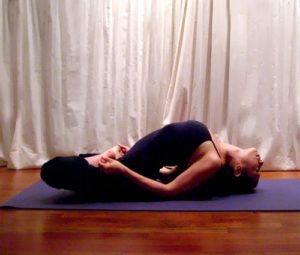Improve the Psychological Health of Women with Uterine Bleeding with Yoga
By John M. de Castro, Ph.D.
“Overall, exercise has positive effects on your period. It is interesting to note that women who are sedentary and do not get regular exercise typically have heavier and more painful periods. Get moving. After all, who wouldn’t want a lighter period with less cramping? “ – Andrea Chisholm
Dysfunctional uterine bleeding (DUB, also called menorrhagia) is a condition that affects nearly every woman at some point in her life, particularly between the ages of 30 to 49 years. It involves vaginal bleeding occurring outside of the regular menstrual cycle. The main cause of dysfunctional uterine bleeding is an imbalance in the sex hormones. Certain medical conditions, hormonal conditions, and medications may also trigger DUB. Stress may also evoke or exacerbate DUB. It is generally temporary and subsides as hormones become normalized, sometimes with the use of oral contraceptives.
Yoga practice has been shown to help regularize and menstrual cycle, help to improve menstrual disorders, and to reduce stress responses. So, it would seem reasonable to investigate the application of yoga practice for Dysfunctional uterine bleeding (DUB). In today’s Research News article “Yoga as a Therapeutic Intervention in the Management of Dysfunctional Uterine Bleeding: A Controlled Pilot Study.” (See summary below or view the full text of the study at: https://www.ncbi.nlm.nih.gov/pmc/articles/PMC5879852/ ), Nalgirkar and colleagues recruited adult women aged 20 to 40 years who were diagnosed with Dysfunctional uterine bleeding (DUB) and randomly assigned them to either no-treatment or 3 months of Integrated Approach of Yoga Therapy (IAYT) . They practiced meditation, postures, and breathing exercises for 60 minutes 3 days per week. They were measured before and after training for blood loss–comprising hemoglobin, pictorial blood loss assessment chart, endometrial thickness, and psychological assessments of anxiety, perceived stress, and sleep quality.
They found that in comparison to baseline and the no-treatment group, after treatment, the yoga group had significantly lower levels of anxiety and perceived stress, and improved sleep quality. But, there were no significant differences in blood loss. Hence, yoga did not improve the primary symptoms of Dysfunctional uterine bleeding (DUB), but, did significantly improve the psychological well-being of the women. This should improve the quality of life of women suffering from DUB.
So, improve the psychological health of women with uterine bleeding with yoga.
“Excessive bleeding is another problem which many women have to face during the menstrual cycle. This leads to discomfort in the women. The pain accompanied with the heavy bleeding can disturb the normal work of the woman. Yoga asanas can be very helpful in dealing with this problem. The various asanas help the women in concentrating on the emotional disturbances that are accompanied with the menstrual cycle. It also helps in gaining inner strength.” – DIY Health
CMCS – Center for Mindfulness and Contemplative Studies
This and other Contemplative Studies posts are also available on Google+ https://plus.google.com/106784388191201299496/posts and on Twitter @MindfulResearch
Study Summary
Nalgirkar, S. P., Vinchurkar, S. A., Saoji, A. A., & Mohanty, S. (2018). Yoga as a Therapeutic Intervention in the Management of Dysfunctional Uterine Bleeding: A Controlled Pilot Study. Journal of Mid-Life Health, 9(1), 8–13. http://doi.org/10.4103/jmh.JMH_76_17
Abstract
Background:
Dysfunctional uterine bleeding (DUB) is one of the most common gynecological disorders encountered in women during the reproductive age. Yoga therapy has shown promising benefits in several gynecological disorders.
Methods:
Thirty women between the ages of 20 and 40 years with primary DUB were randomly assigned to a yoga (n = 15) and a waitlist control group (n = 15). Participants in the yoga group received a 3-month yoga module and were assessed for hemoglobin values, endometrial thickness (ET), pictorial blood loss assessment chart (PBAC), State-Trait Anxiety Inventory, perceived stress scale, and Pittsburgh Sleep Quality Index (PSQI) before and after a 3-month follow-up period.
Results:
At the end of 3 months of intervention, the yoga group, unlike the control group, reported a significant reduction in the anxiety scores (P < 0.05) and perceived stress (P < 0.05). The PSQI scores indicated a reduction in sleep disturbances (P < 0.001) and the need for sleep medications (P < 0.01) and higher global scores (P < 0.001). However, there were no changes in PBAC and ET in both the groups.
Conclusion:
The results indicate that yoga therapy positively impacts the outcome of DUB by reducing the perceived stress and state anxiety and improving the quality of sleep. This warrants larger clinical trials to validate the findings of this pilot study.
https://www.ncbi.nlm.nih.gov/pmc/articles/PMC5879852/

Yoga can significantly enhance the psychological well-being of women experiencing uterine bleeding by reducing stress and promoting relaxation. Integrating yoga into their routine may help manage symptoms and improve overall quality of life.